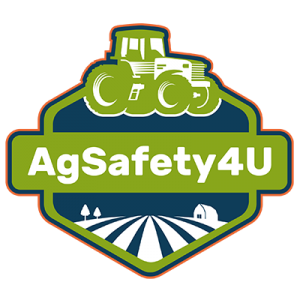
AgSafety4U is a joint effort between the University of Nebraska, Pennsylvania State University, and the Ohio State University who recognized the need for formalized agricultural safety and health education for agricultural workers, has developed an online certificate course that provides an overview of the hazards common to farms and rural agricultural businesses. The course offers a general outline of the measures agricultural workers can take to identify and control such hazards.
AgSafety4u is an online course designed for youth, new and beginning farmers, and for employers and employees of agricultural operations looking to enhance their knowledge and/or to provide professional development with a heavy emphasis on tractor and machinery. Individuals who take this course and pass the online quizzes will be able to print a certificate of completion.
This program can be used for the classroom portion of the Hazardous Occupations Order for Agriculture (HOOA) safety certification program for youth 14 and 15 years of age who are seeking employment and must be certified to drive or operate tractors and machinery for hire. Additional hands-on training is required for issuing a US DOL certificate.
Website Link
Click HERE to register for the AgSafety4u certificate course.
Click HERE to purchase bulk class enrollments.
Cost
The certificate course costs $10.00 per person. Participants receive a certificate upon completion of the course.
Target Audience
The certificate course was developed for agricultural employees, employers, and other rural workers.
Learning Objectives and Goals
The AgSafety4u certificate course organizes training in six modules, each of which focuses on a particular subject area.
Module 1: Introduction
The introductory module provides an overview of agriculture, types of risks, and regulations related to safety and health.
Module 2: Safety Basics
This module provides information on the following topics:
- Injuries involving youth
- Age-appropriate tasks for youth
- Appropriate clothing for working on the farm
- Hazard warning signs
- Hand signals
- Personal protective equipment (PPE)
- First aid basics
Module 3: Agricultural Hazards
This module outlines information on the following topics:
- Mechanical hazards and associated safety considerations
- Animals
- Agricultural pesticides
- Electrical hazards
- Confined spaces, silos, grain bins, and manure storage areas
- Anhydrous ammonia
- Farmstead chemicals
Module 4: The Tractor
This module includes the following topics:
- Tractor types
- Tractor hazards
- Guidelines for age-appropriate tasks for children and youth
- Tractor instrument panels
- Tractor controls (stop engine, ground motion, power engagement, and positioning and adjusting)
- Operation symbols and the location and movement of tractor controls
- Preventative maintenance and pre-operation checks
- Jumper cables
- Tractor stability
- Lighting and marking
The module also addresses the following activities:
- Starting and stopping diesel and gasoline engines
- Mounting and dismounting and starting and stopping a tractor
- Moving and steering a tractor
- Operating a tractor in reverse
- Using a tractor safely
- Operating a tractor on public roads
Module 5: Connecting and Using Implements with the Tractor
This module provides information on the following topics:
- Connecting implements to a tractor
- Using draw bar implements
- Using three-point hitch implements
- Making power take-off (PTO) connections
- Using PTO implements
- Using implements with hydraulic components
- Using implements with electrical connections
Module 6: Materials Handling
This module covers the use of the following vehicles:
- Skid steers
- All-terrain vehicles (ATVs)
- Utility vehicles
Evaluation
Participants must complete an online quiz at the end of each module. Once a score of at least 70% is achieved on each module, the participant will be issued a digital certificate and badge.
